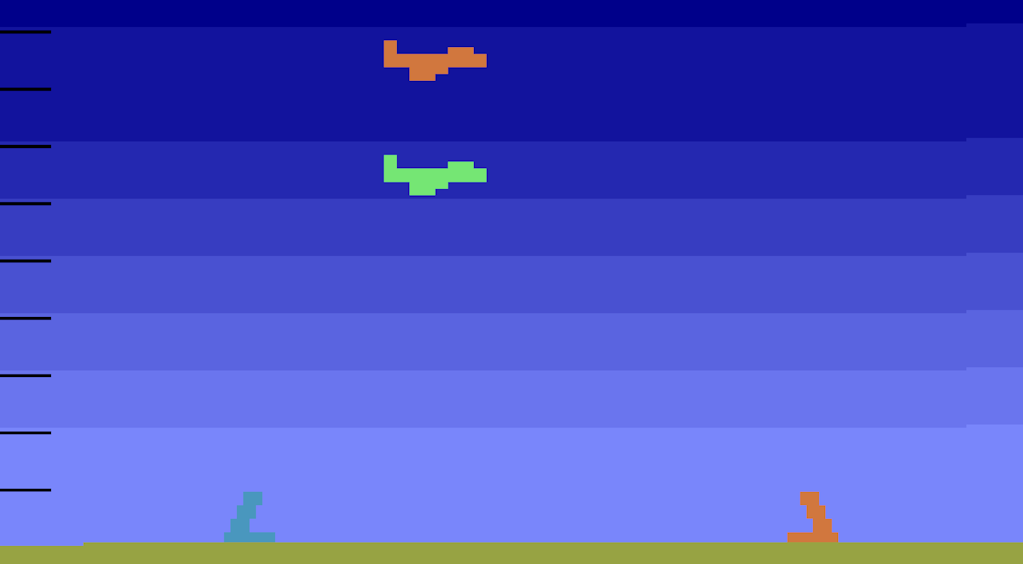
Console Gaming History Adventure: 1977
This is a continuation of my Console Gaming History Adventure series that started with 1976, where I try out nearly every English-friendly console game released for each year of gaming history and share my experiences. Today, that’s 1977, the same year the “Star Wars” movie came out! While there still isn’t a lot of activity in the console gaming arena compared to later years, the situation is a lot better than it was for 1976, with 25 new games across 20 new cartridges to take a look at!
New Consoles
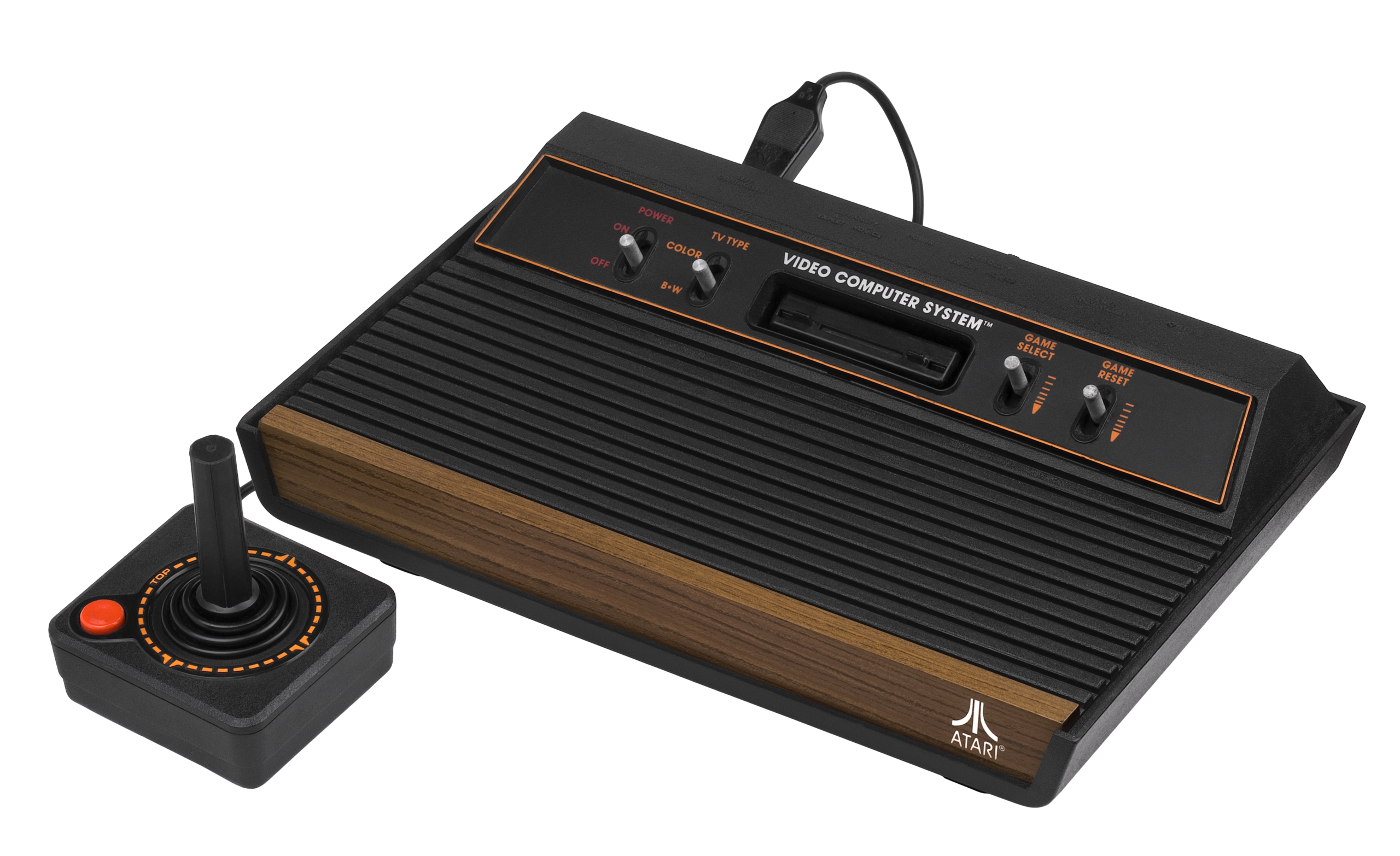 While the Fairchild Channel F had free reign of the cartridge-based console gaming market for most of the year, that changed in September with the release of the Atari Video Computer System (VCS). The VCS could handle a screen resolution of 160×192 with 128 different possible colors for games to choose from (NTSC), considerably better than the 104×60 resolution and 8 possible colors of the Fairchild Channel F, though graphical limitations meant many graphical elements in Atari VCS games had to use double-sized pixels. The VCS also had 128 bytes of RAM, double that of the Channel F! All this and it was only slightly more expensive than the Channel F, with an introductory price of 189.95USD (979.00USD in today’s money). The Atari VCS was released in many different models with different appearances over time – the image I included here is actually the 1980 model.
While the Fairchild Channel F had free reign of the cartridge-based console gaming market for most of the year, that changed in September with the release of the Atari Video Computer System (VCS). The VCS could handle a screen resolution of 160×192 with 128 different possible colors for games to choose from (NTSC), considerably better than the 104×60 resolution and 8 possible colors of the Fairchild Channel F, though graphical limitations meant many graphical elements in Atari VCS games had to use double-sized pixels. The VCS also had 128 bytes of RAM, double that of the Channel F! All this and it was only slightly more expensive than the Channel F, with an introductory price of 189.95USD (979.00USD in today’s money). The Atari VCS was released in many different models with different appearances over time – the image I included here is actually the 1980 model.
The Atari VCS’s standard joystick controller was more limited, with only one button and a joystick for 4-way movement, but there were other controllers too! Some games required “paddle” controllers, which came in pairs that plugged two into a single controller port. Other games required “driving” controllers. Both had one button and a dial you could rotate for movement, but the paddle controllers were for moving something back and forth smoothly within a limited range, and could only turn 360° before hitting a hard stop, while the driving controllers were for steering/rotating and could turn endlessly. The paddle/driving controller dials were actually analog, so that games could tell a full range of how far you had turned the dial, rather than just whether you had turned it at all. Analog support was unusual for game consoles of the time. The standard joystick controller is digital-only – it could send a signal to the console that you were pushing it or not pushing it, but not how far you were pushing it. That meant it wasn’t possible to move your player character at different speeds based on how hard you pushed the joystick like with more modern consoles, which basically meant the joystick was just a clumsier version of a control pad. 😕
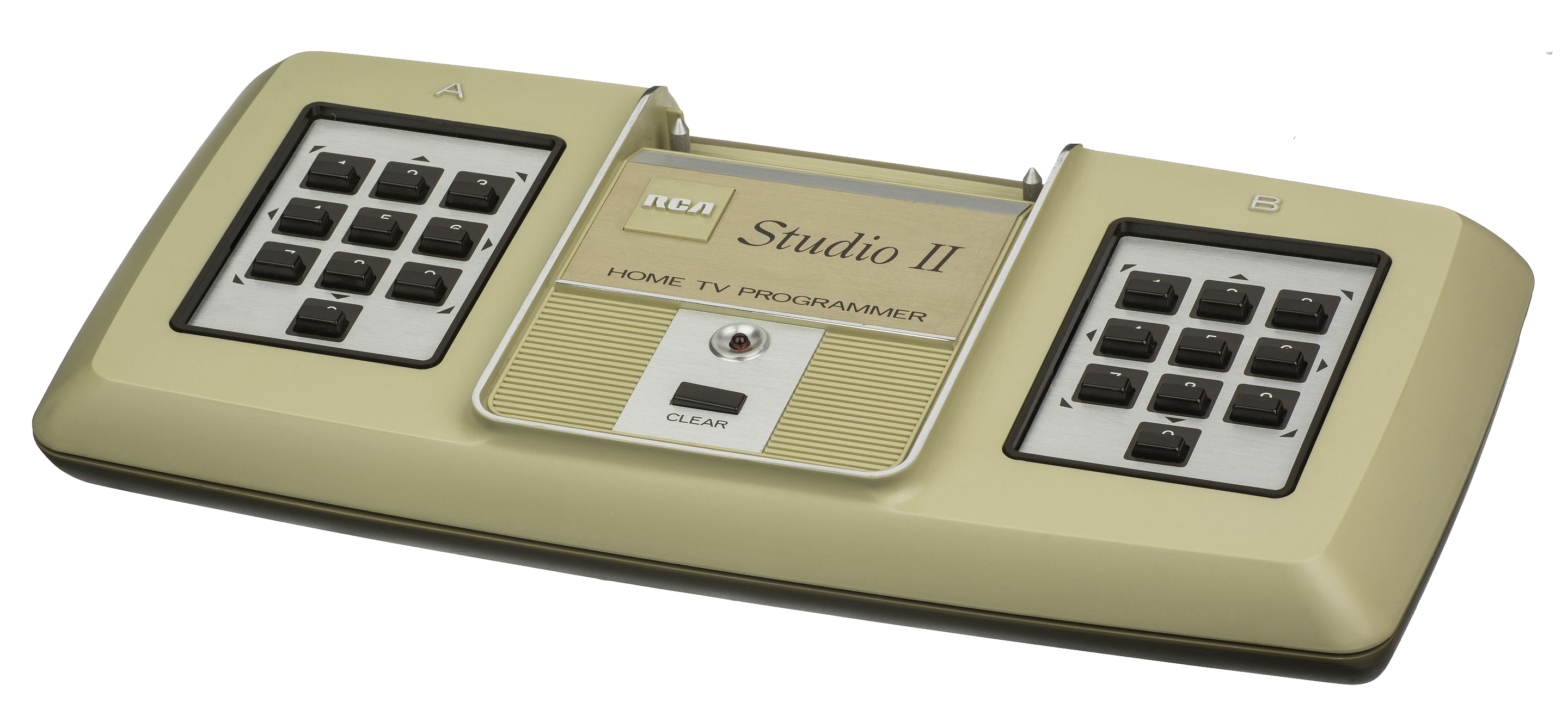 (NO ACCESS) Another console available this year was called the RCA Studio II, but I don’t have access to the console or to any of its games, emulated or otherwise. I’m going to indicate that going forward using a red “No Access” flag but I’ve decided it’s worth mentioning any consoles I can find info about anyway for contextual comparison to the stuff I do have access to.
(NO ACCESS) Another console available this year was called the RCA Studio II, but I don’t have access to the console or to any of its games, emulated or otherwise. I’m going to indicate that going forward using a red “No Access” flag but I’ve decided it’s worth mentioning any consoles I can find info about anyway for contextual comparison to the stuff I do have access to.
The RCA Studio II is likely the most primitive home console to be mentioned in this series, with support for only 2 possible colors – white and black with no shades of gray. Since it was even more primitive than the Fairchild Channel F released the previous year, it had no hope of success and died a quick death. PC World apparently called it “the worst video game console of all time”. 😐 The console cost 149.95USD (823.10USD in today’s money) at launch.
Technically, a third console, the Bally Professional Arcade, was “available” this year, but you couldn’t buy it until December, and even then only by mail order. Because of production problems, you couldn’t buy it in stores until April of 1978, and I haven’t been able to find an answer on whether the mail-order units were able to arrive at people’s houses before New Year’s Day. It was a tough decision, but I’ve decided to cover this console, along with the games for it that were supposed to come out in 1977, in the next article.
Returning Consoles
The Fairchild Channel F continued to be sold and to have new games available for it this year. In fact, this was easily its peak year of new games! But with the arrival of the Atari VCS, it would survive only a few more years before this unique and interesting system was bullied out of the market. Such are the cruelties of capitalism. ☹️
Noteworthy Games
Without the inclusion of the Bally Professional Arcade, my options for this list are more limited than I’d hoped, even though it still leaves me with more than three times as many games to pick from compared to last year. I’ve been particularly disappointed with the 11 Fairchild Channel F cartridges released this year, because even with all those choices, none of them seem anywhere near as good to me as the games I recommended for 1976. ☹️ And while the Atari VCS allowed games to have much better graphics, its one-button joystick controller really limited how complex those games could be! Overall I think this was a very bland year for console gaming even with the grand entrance of the legendary VCS being a part of it, but that’s okay. There are still a few nice titles to recommend! 🙂
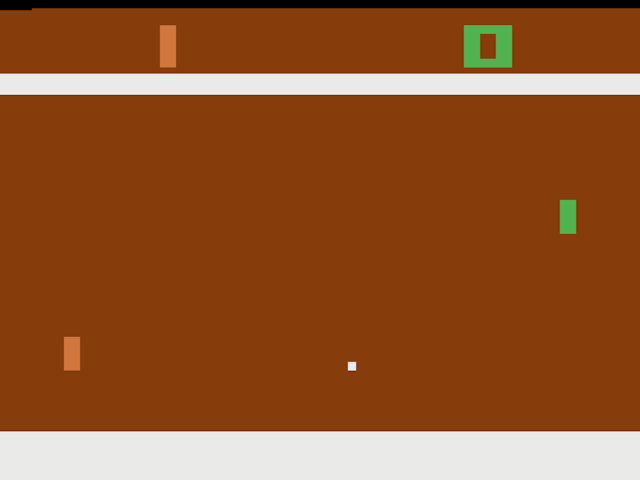 One game I think is worth including here is Video Olympics. While it sounds like a series of sports games, and it kinda is, what it’s effectively offering is a large number of variations of Pong, many with changes modeled around different kinds of sports. I’m including it on this list because while nearly all the included game variations are two-player only, there is a single mode of classic pong (Game Variant #2) where you can play against the computer, giving you a one-player compatible version of Pong to play with. I thought that was neat because of Pong’s enormous historical significance to early console gaming. Be warned – the computer is very tough! Not to suggest I’m a particularly skillful gamer, but yeah I just wasn’t able to beat this guy! 😵💫
One game I think is worth including here is Video Olympics. While it sounds like a series of sports games, and it kinda is, what it’s effectively offering is a large number of variations of Pong, many with changes modeled around different kinds of sports. I’m including it on this list because while nearly all the included game variations are two-player only, there is a single mode of classic pong (Game Variant #2) where you can play against the computer, giving you a one-player compatible version of Pong to play with. I thought that was neat because of Pong’s enormous historical significance to early console gaming. Be warned – the computer is very tough! Not to suggest I’m a particularly skillful gamer, but yeah I just wasn’t able to beat this guy! 😵💫
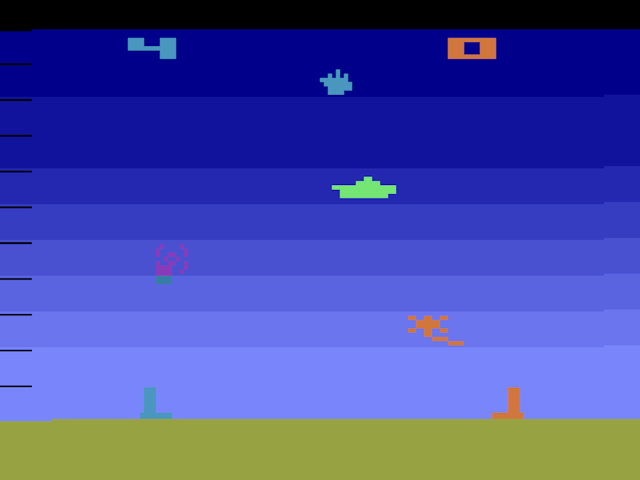 Another game I don’t think is too bad is Air-Sea Battle for the Atari VCS, which I guess is based on Atari’s 1975 “Anti-Aircraft”, an arcade game kinda similar to the “Sea Wolf” that was featured in the last article. While Air-Sea Battle is oriented around two player competition, where you see who can hit the most targets in a limited amount of time, there is a very simple computer player you can compete against who just continually holds down the fire button. You can also just ignore the two player mechanic and play with one of the controllers, firing at the targets on your own to see how many points you can score within the time limit.
Another game I don’t think is too bad is Air-Sea Battle for the Atari VCS, which I guess is based on Atari’s 1975 “Anti-Aircraft”, an arcade game kinda similar to the “Sea Wolf” that was featured in the last article. While Air-Sea Battle is oriented around two player competition, where you see who can hit the most targets in a limited amount of time, there is a very simple computer player you can compete against who just continually holds down the fire button. You can also just ignore the two player mechanic and play with one of the controllers, firing at the targets on your own to see how many points you can score within the time limit.
Air-Sea Battle has a very large number of game variants with varying features like the ability to move left and right, the ability to change the direction of your fire, and steerable missiles. Visual themes include blowing up aircrafts with a missile launcher, blowing up aircrafts from a ship, blowing up ships from an aircraft, and playing at a shooting gallery. There are also game variants where you and your human or computer opponent directly attack each other as a plane and submarine!
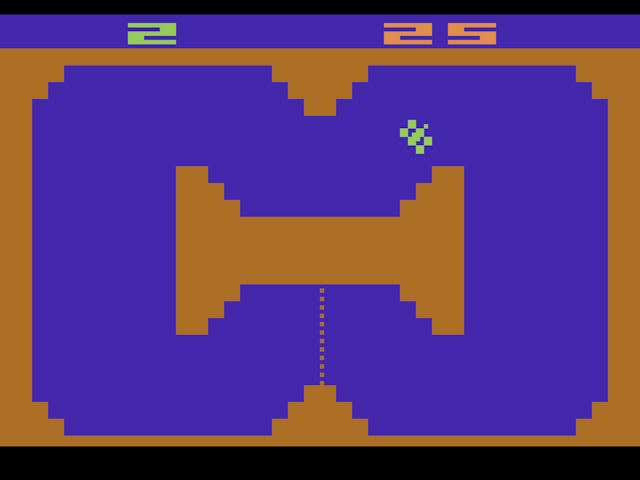 Clearly based on the Sprint/Indy 800 series of arcade games, Indy 500 for the VCS can also offer some entertainment. It’s a racing game played in an overhead view, meant for competitive racing between two players, but it also has a one-player Time Trial mode where you just try and complete as many laps as possible within the time limit. There are three different tracks to choose from, a simpler “Grand Prix” track, a more difficult “Devil’s Elbow” track, and an even more difficult variant of the “Grand Prix” track that is covered in ice. There is also a “Crash ‘n Score” mode where instead of racing, you and your opponent wander around an open area trying to catch the most dots, which also offers a Time Trial mode for playing on your own. You can even play the classic children’s game of “Tag” in a similar open area with a human opponent. Wikipedia claims the Crash ‘n Score game variant supports a computer opponent, but I’ve played this game thoroughly and read the instruction booklet that comes with the game, and I’m not seeing anything like this. I think it would be asking a lot of the Atari VCS to do something like that…
Clearly based on the Sprint/Indy 800 series of arcade games, Indy 500 for the VCS can also offer some entertainment. It’s a racing game played in an overhead view, meant for competitive racing between two players, but it also has a one-player Time Trial mode where you just try and complete as many laps as possible within the time limit. There are three different tracks to choose from, a simpler “Grand Prix” track, a more difficult “Devil’s Elbow” track, and an even more difficult variant of the “Grand Prix” track that is covered in ice. There is also a “Crash ‘n Score” mode where instead of racing, you and your opponent wander around an open area trying to catch the most dots, which also offers a Time Trial mode for playing on your own. You can even play the classic children’s game of “Tag” in a similar open area with a human opponent. Wikipedia claims the Crash ‘n Score game variant supports a computer opponent, but I’ve played this game thoroughly and read the instruction booklet that comes with the game, and I’m not seeing anything like this. I think it would be asking a lot of the Atari VCS to do something like that…
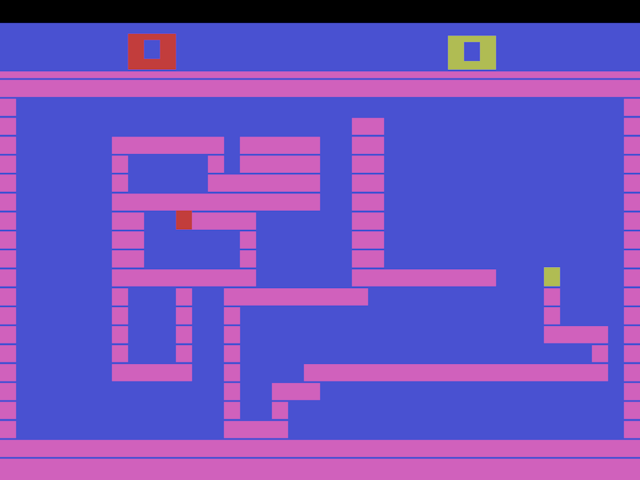 I think my favorite console game from 1977 would be Surround for the VCS, which seems to be based a number of similar arcade games with different names that were released across 1976 and 1977. You and your opponent leave trails behind you as you move around. The goal of the game is to force your opponent run into either your trail or their own before they can do the same to you! The game is simple but involves some degree of strategy, which I guess is why I like it. There’s a computer opponent you can face off with, but he isn’t too bright. Game Variant #4 though can make him a bit more challenging to beat by increasing the speed of the game the longer the both of you survive.
I think my favorite console game from 1977 would be Surround for the VCS, which seems to be based a number of similar arcade games with different names that were released across 1976 and 1977. You and your opponent leave trails behind you as you move around. The goal of the game is to force your opponent run into either your trail or their own before they can do the same to you! The game is simple but involves some degree of strategy, which I guess is why I like it. There’s a computer opponent you can face off with, but he isn’t too bright. Game Variant #4 though can make him a bit more challenging to beat by increasing the speed of the game the longer the both of you survive.
Meanwhile, in Arcade Land…
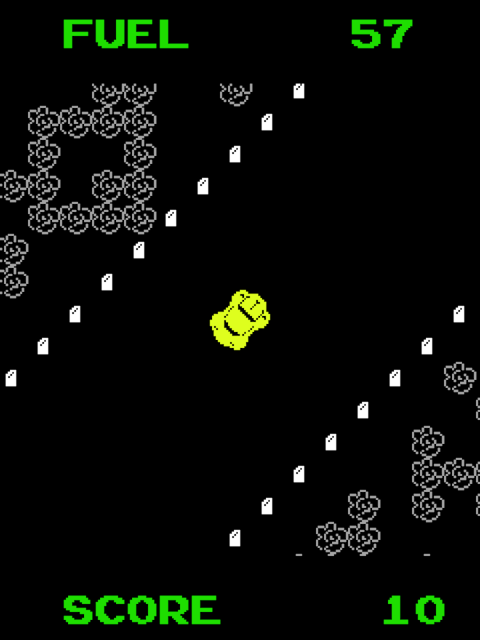 From what I can see, the overwhelming majority of really fun, high quality 1977 video games continued to be something you had to visit an arcade to play. While the arcade games I have access to do seem slightly more sophisticated than the ones from 1976, I’m not really seeing any radical advancements. Out of the ones I played, I’d have to say Super Bug is the best, where you simply drive a car around and try to get as far as possible before your fuel runs out. My only complaint about it is the manual transmission because I don’t like having to worry about shifting gears. The game software is monochrome, but a physical screen overlay on the arcade machine’s display tints the car yellow and the score and fuel indicators green. You can see it best when you get close to something with the car, because anything close enough to be in the yellow circle of the overlay in the center of the screen is also gonna get tinted. 😐
From what I can see, the overwhelming majority of really fun, high quality 1977 video games continued to be something you had to visit an arcade to play. While the arcade games I have access to do seem slightly more sophisticated than the ones from 1976, I’m not really seeing any radical advancements. Out of the ones I played, I’d have to say Super Bug is the best, where you simply drive a car around and try to get as far as possible before your fuel runs out. My only complaint about it is the manual transmission because I don’t like having to worry about shifting gears. The game software is monochrome, but a physical screen overlay on the arcade machine’s display tints the car yellow and the score and fuel indicators green. You can see it best when you get close to something with the car, because anything close enough to be in the yellow circle of the overlay in the center of the screen is also gonna get tinted. 😐
Conclusion
This is the last year where the selection of console games is really all that limited, and things really kick into high gear (not a Super Bug pun) with 1978. Like I said with the last article, I’ve already actually made it to 1979, so it should be pretty quick and easy to get an article out for 1978. After that though, it’s going to be a loong time before I can continue this series because I have a lot of 1979 games to work through! For now, let me know how I did in the comments!